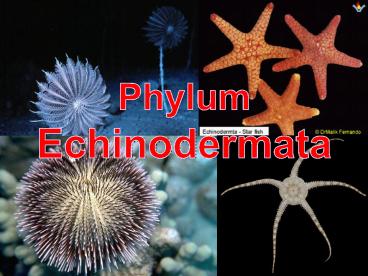Phylum Echinodermata - PowerPoint PPT Presentation
1 / 17
Title:
Phylum Echinodermata
Description:
General Facts. Classified under the superphylum Deuterostomia. Adult organisms ... sent to the ampullae. ... Anus. Class Asteroidea. Around 1,800 sp. ... – PowerPoint PPT presentation
Number of Views:620
Avg rating:3.0/5.0
Title: Phylum Echinodermata
1
Phylum Echinodermata
2
General Facts
- Classified under the superphylum Deuterostomia
- Adult organisms have pentamerous symmetry
- They have a water-vascular system
- Ossicles Endoskeleton
- Found at every ocean depth
- 7,000 living species
3
Water Vascular System
Only found in Echinoderms
Functions differ between species but general
functions include Locomotion, Attatchment,
Feeding etc.
- Water enters the
- madreporite.
- Flows through the
- stone canal.
- Then enters
- the circular ring
- canal.
- Water is then
- sent to the ampullae.
4
Classes
- Crinoidea - Sea Lillies or Feather Stars
- Asteroidea - Starfish
- Ophiuroidea - Brittle Stars
- Echinoidea - Sea Urchins and Sand Dollars
- Holothuroidea Sea Cucumbers
5
Class Crinoidea
- The first class to originate that is still around
today. - Live in depths anywhere up to 6,000m.
- Mouth is present on the top surface, usually
surrounded by feeding arms. - U-Shaped Gut
- Most crinoids have many arms but the basic
five-fold symmetry can still be seen. - Many have a stem as infants but not at adulthood.
6
Crinoidean Physiology
Ambulacral Groove
- 3 Basic Sections
- Stem, Calyx and
- Brachials (Arms)
Anus
Pinnules
Ray
Interesting Fact About Motility Prior to 2005 it
was widely known that stalked crinoids could
move, but the fastest rate of movement recorded
was 0.6m/h. However on the seafloor off the
Grand Bahama Island a stalked crinoid was
recorded travelling at a speed of 140 m/h.
Calyx
Stalk
Cirri
7
Class Asteroidea
- Around 1,800 sp.
- Typically have 5 arms but the number of limbs can
differ even within a species - Display pentaradial symmetry
- Water Vascular System (WVS) Unique to
echinoderms - Feed on shelled animals such as oysters and clams
- Have 2 stomachs
- Can regenerate arms
8
Asteroidean Physiology
- Mouth located on the ventral surface
- Dorsal Surface is spiny
- Madreporite on dorsal surface
- Pedicellariae surround the spines
- Radial Canal Ampullae
- They have 1 microscopic eye on the end of each
arm useful for detecting movement. - Internally, they have a complex nervous system
but lack a centralized brain.
9
Class Ophiuroidea
- Body outline similar to Asteroidea
- Whip-like arms up to 60cm in length
- Around 1,500 sp.
- Most live below 500m
- However also commonly found on reefs
10
Ophiuroidean Physiology
- Central Disc is sharply marked off from the arms
- The Disc contains all of the viscera
- Nervous system based in the central disc with
radial nerves in the arms - They have no eyes but can detect light and dark
through the epidermis
11
Class Echinoidea
- Relatively Small Test only 2-10cm across
- The biggest component in class enchinodermata
- Found all over the world
- Move slowly
- Feed mostly on algae
- They have a skin of moveable spines
12
Echinoidean Physiology
Test Of A Sea Urchin
- Pentamorous symmetry
- can only be distinguished
- when looking at the test.
- Larval stage Crystalline bones build up the
endoskeletan - The fully formed spicule comprises of a single
crystal. - Aristotles Lantern The
- whole chewing organ
13
Aristotles Lantern
Dorsal
The mouth is located on the oral surface of the
organism and is made up of 5 calcium carbonate
teeth and a fleshy tongue like structure within.
Oral
14
Class Holothuroidea
- Usually scavengers.
- Evisceration Sticky cuvierian tubules entangle
predators - Replacement tubules grow back in 2 5 weeks
- Can live in very dense populations
- They have a single branched gonad
- An endoskeleton is present just beneath the skin
15
Holothuroidean Physiology
- Tentacles Ensnare prey/sediment and transport
it to the mouth. - Respiratory trees hold water and oxygen is the
extracted from the water and spread round the
body in the hemal (circulatory) system.
16
(No Transcript)
17
Thank you for watching my presentation































